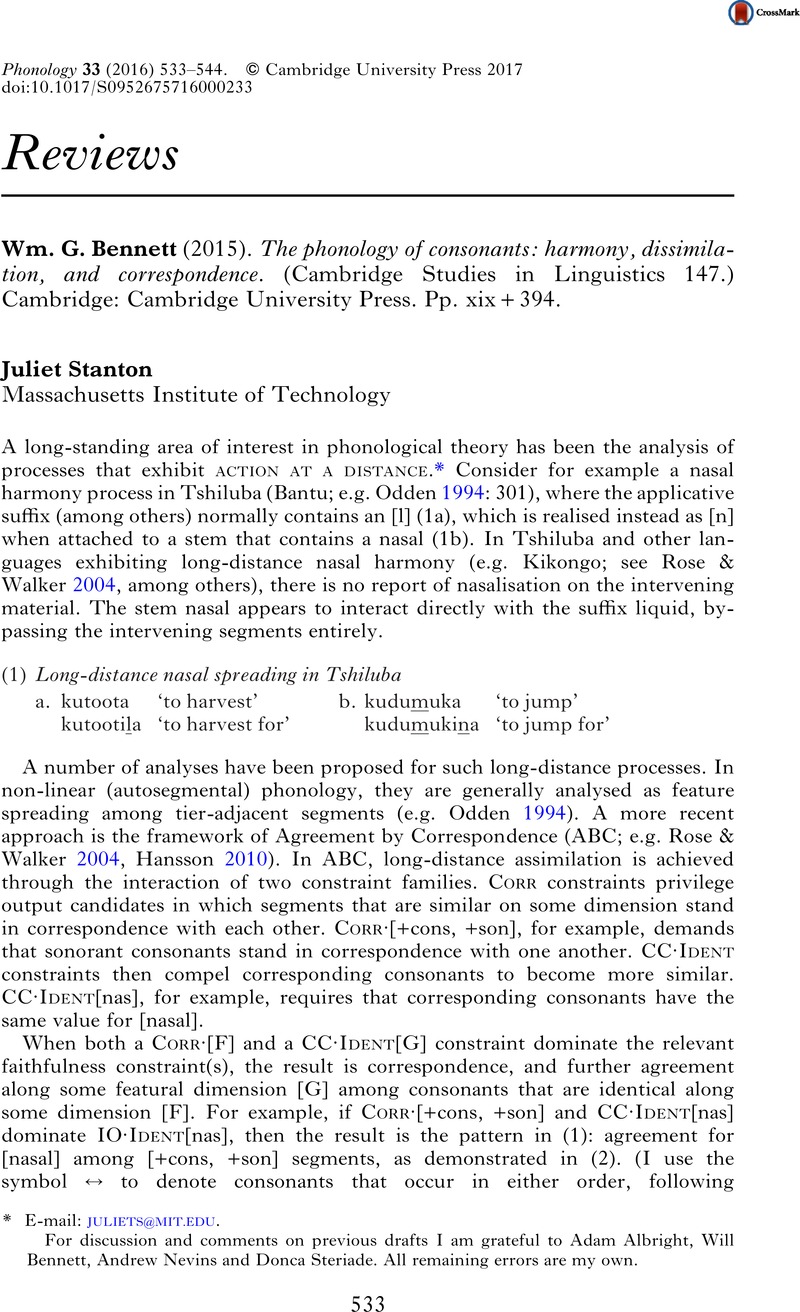No CrossRef data available.
Article contents
Wm. G. Bennett(2015). The phonology of consonants: harmony, dissimilation, and correspondence. (Cambridge Studies in Linguistics 147.) Cambridge: Cambridge University Press. Pp. xix+394.
Review products
Wm. G. Bennett(2015). The phonology of consonants: harmony, dissimilation, and correspondence. (Cambridge Studies in Linguistics 147.) Cambridge: Cambridge University Press. Pp. xix+394.
Published online by Cambridge University Press: 16 January 2017
Abstract
An abstract is not available for this content so a preview has been provided. Please use the Get access link above for information on how to access this content.

Information
- Type
- Reviews
- Information
- Copyright
- Copyright © Cambridge University Press 2017
References
REFERENCES
Balusu, Rahul (2011). OCP effects in Telugu. In Lee, Wai-Sum & Zee, Eric (eds.) Proceedings of the 17th International Congress of Phonetic Sciences, Hong Kong 2011. Hong Kong: University of Hong Kong. 284–287.Google Scholar
Bennett, William G. (2013). Dissimilation, consonant harmony, and surface correspondence. PhD dissertation, Rutgers University.Google Scholar
Berent, Iris & Shimron, Joseph (2003). Co-occurrence restrictions on identical consonants in the Hebrew lexicon: are they due to similarity?
JL
39. 31–55.Google Scholar
Coetzee, Andries W. & Pater, Joe (2008). Weighted constraints and gradient restrictions on place co-occurrence in Muna and Arabic. NLLT
26. 289–337.Google Scholar
Cohn, Abigail (1992). The consequences of dissimilation in Sundanese. Phonology
9. 199–220.Google Scholar
Colavin, Rebecca S., Levy, Roger & Rose, Sharon (2010). Modeling OCP-Place in Amharic with the Maximum Entropy phonotactic learner. CLS
46:2. 27–41.Google Scholar
Frisch, Stefan A., Pierrehumbert, Janet B. & Broe, Michael B. (2004). Similarity avoidance and the OCP. NLLT
22. 179–228.Google Scholar
Gallagher, Gillian (2011). Acoustic and auditory features in phonology: the case for [long VOT]. The Linguistic Review
28. 281–303.Google Scholar
Gallagher, Gillian (2013). Learning the identity effect as an artificial language: bias and generalisation. Phonology
30. 253–295.CrossRefGoogle Scholar
Gallagher, Gillian & Coon, Jessica (2009). Distinguishing total and partial identity: evidence from Chol. NLLT
27. 545–582.Google Scholar
Graff, Peter & Jaeger, T. Florian (2009). Locality and feature specificity in OCP effects: evidence from Aymara, Dutch, and Javanese. CLS
45. 127–141.Google Scholar
Hansson, Gunnar Ólafur (2010). Consonant harmony: long-distance interaction in phonology. Berkeley: University of California Press.Google Scholar
Kawahara, Shigeto, Ono, Hajime & Sudo, Kiyoshi (2006). Consonant co-occurrence restrictions in Yamato Japanese. In Vance, Timothy J. & Jones, Kimberly (eds.) Japanese/Korean linguistics 14. Palo Alto: CLSI. 27–38.Google Scholar
Lee, Borim (1991). Prosodic structures in Takelma phonology and morphology. PhD dissertation, University of Texas at Austin.Google Scholar
McCarthy, John J. (1988). Feature geometry and dependency: a review. Phonetica
45. 84–108.Google Scholar
MacEachern, Margaret (1997). Laryngeal cooccurrence restrictions. PhD dissertation, University of California, Los Angeles.Google Scholar
Mester, R. Armin (1986). Studies in tier structure. PhD dissertation, University of Massachusetts, Amherst.Google Scholar
Mustafawi, Eiman (2011). The OCP as a synchronic constraint in Qatari Arabic. Canadian Journal of Linguistics
56. 229–246.Google Scholar
Padgett, Jaye (1991). Stricture in feature geometry. PhD dissertation, University of Massachusetts, Amherst.Google Scholar
Pierrehumbert, Janet B. (1993). Dissimilarity in the Arabic verbal roots. NELS
23. 367–381.Google Scholar
Rose, Sharon & King, Lisa (2007). Speech error elicitation and co-occurrence restrictions in two Ethiopian Semitic languages. Language and Speech
50. 451–504.CrossRefGoogle ScholarPubMed
Rose, Sharon & Walker, Rachel (2004). A typology of consonant agreement as correspondence. Lg
80. 475–531.Google Scholar
Suzuki, Keiichiro (1998). A typological investigation of dissimilation. PhD dissertation, University of Arizona.Google Scholar
Thomas, Jacqueline M. C. (1963). Le parler Ngbaka de Bokanga: phonologie, morphologie, syntaxe. Paris: Paillart.Google Scholar
Walker, Rachel, Byrd, Dani & Mpiranya, Fidèle (2008). An articulatory view of Kinyarwanda coronal harmony. Phonology
25. 499–535.Google Scholar
Yip, Moira (1989). Feature geometry and cooccurrence restrictions. Phonology
6. 349–374.CrossRefGoogle Scholar
Zymet, Jesse (2014). Distance-based decay in long-distance phonological processes: a probabilistic model for Malagasy, Latin, English, and Hungarian. PhD dissertation, University of California, Los Angeles.Google Scholar

